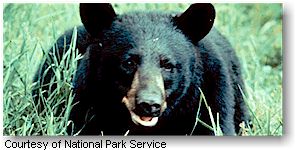|
 Great Smoky Mountains National Park contains some of the largest tracts of wilderness in the East and is a critical sanctuary for a wide variety of animals. Protected in the park are some 66 species of mammals, over 200 varieties of birds, 50 native fish species, and more than 80 types of reptiles and amphibians. Great Smoky Mountains National Park contains some of the largest tracts of wilderness in the East and is a critical sanctuary for a wide variety of animals. Protected in the park are some 66 species of mammals, over 200 varieties of birds, 50 native fish species, and more than 80 types of reptiles and amphibians.
Great Smoky Mountains National Park is one of the few places remaining in the eastern United States where black bears can live in wild, natural surroundings. For many, this famous Smokiesí resident is a symbol of wilderness.
Bears inhabit all elevations of the park. Though populations are variable, counts conducted in 2004 indicated approximately 1,600 bears live in the park. This equals a population density of approximately two bears per square mile. At one time, the black bearís range included most of North America except the extreme west coast. Because of the loss of habitat, the black bear is now confined to wooded areas or dense
brushland.
All black bears in the park are black in color, but in other parts of the country they may be brown or cinnamon. They may be six feet in length and up to three feet high at the shoulder. During the summer months, a typical male bear weighs approximately 250 pounds while females are generally smaller and weigh less slightly over 100 pounds. However, bears may double their weight by the fall. Bears over 600 pounds have been documented in the park. Wild bears can live 12-15 years or more. "Panhandler" bears, who have had access to human foods and garbage, have a life expectancy of only half that time.
Bears, like humans, are omnivores. Plant materials such as berries and nuts make up approximately 85% of their diet. Insects and animal carrion provide valuable sources of protein for bears.
Bears have color vision and a keen sense of smell. In addition, they are good tree climbers, can swim very well, and can run 30 miles per hour.
|



